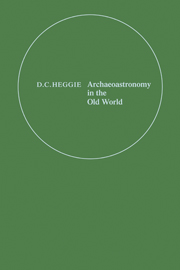Book contents
- Frontmatter
- Contents
- PREFACE
- LIST OF CONTRIBUTORS
- INVITED PAPERS
- MEGALITHIC ASTRONOMY: HIGHLIGHTS AND PROBLEMS
- ARCHAEOLOGY AND ASTRONOMY: AN ARCHAEOLOGICAL VIEW
- THE STATISTICAL APPROACH
- STATISTICAL AND PHILOSOPHICAL ARGUMENTS FOR THE ASTRONOMICAL SIGNIFICANCE OF STANDING STONES WITH A SECTION ON THE SOLAR CALENDAR
- MEGALITHIC ASTRONOMICAL SIGHTLINES: CURRENT REASSESSMENT AND FUTURE DIRECTIONS
- ASPECTS OF THE ARCHAEOASTRONOMY OF STONEHENGE
- IMPLICATIONS FOR ARCHAEOLOGY
- PI IN THE SKY
- CONTRIBUTED PAPERS
- INVITED PAPER
- INDEX
STATISTICAL AND PHILOSOPHICAL ARGUMENTS FOR THE ASTRONOMICAL SIGNIFICANCE OF STANDING STONES WITH A SECTION ON THE SOLAR CALENDAR
Published online by Cambridge University Press: 05 November 2011
- Frontmatter
- Contents
- PREFACE
- LIST OF CONTRIBUTORS
- INVITED PAPERS
- MEGALITHIC ASTRONOMY: HIGHLIGHTS AND PROBLEMS
- ARCHAEOLOGY AND ASTRONOMY: AN ARCHAEOLOGICAL VIEW
- THE STATISTICAL APPROACH
- STATISTICAL AND PHILOSOPHICAL ARGUMENTS FOR THE ASTRONOMICAL SIGNIFICANCE OF STANDING STONES WITH A SECTION ON THE SOLAR CALENDAR
- MEGALITHIC ASTRONOMICAL SIGHTLINES: CURRENT REASSESSMENT AND FUTURE DIRECTIONS
- ASPECTS OF THE ARCHAEOASTRONOMY OF STONEHENGE
- IMPLICATIONS FOR ARCHAEOLOGY
- PI IN THE SKY
- CONTRIBUTED PAPERS
- INVITED PAPER
- INDEX
Summary
Abstract. Stressing the importance of the lunar bands, the authors show that within each of these bands, the histograms of declination give strong support to the lunar hypothesis, because of the clustering of the alignments round the expected values. Recently, while considering which lunar band edges would be favourable or unfavourable for the erectors, the authors have discovered a way of presenting the data published up to 1978. This Favourable/Unfavourable objective consideration gives strong support to the hypothesis, since nothing was known of it over the decades when the surveys were made. The method shows a low probability (1 in 433) that the lunar alignments are occurring by chance alone. By reasoning from the viewpoint of the erectors, the authors give several supporting philosophical arguments which by their very nature can not be used statistically; e.g. the warning positions which could well have been occupied by an assistant observer to tell the row of observers at the backsight of the imminent Moonrise. A revised histogram of solar lines is presented with the 16-month calendar based on a 365/366 day year. It is suggested that the erectors had two reasons for recording the Moon's movement; (a) eclipse prediction assisted by their solar calendar and (b) scientific curiosity.
INTRODUCTION
Our knowledge of megaliths can come only from the remains themselves. These consist of standing stones, their positions relative to one another, to tumuli, to mounds, and to nearby tracks on the ground.
- Type
- Chapter
- Information
- Archaeoastronomy in the Old World , pp. 53 - 82Publisher: Cambridge University PressPrint publication year: 1982



